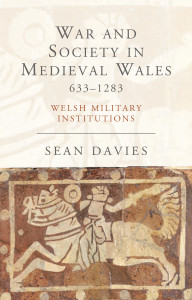
Reviewer: Wouter van Dijk
War and Society in Medieval Wales 633-1283, Sean Davies
Studies in Welsh History Series volume 21
University of Wales Press, Cardiff 2014
ISBN: 978-1-78316-139-3
Paperback, with map, list of abbreviations, bibliography and index
288 pages
£24,99 / €35,99
War in medieval Welsh society
The popular image of the Welsh medieval warrior, and of Welsh medieval armed forces, is that of a brave and reckless fighter, or mass of fighters, but without much tactical skill. To what extent this image is historical correct is subject to Sean Davies’ book War and Society in Medieval Wales 633-1283. With his book on warfare and Welsh society in the Middle Ages, medieval historian dr. Sean Davies wants to modernize the dominant view that still exists about Welsh medieval warfare as a primitive but ferocious enterprise that encompasses the whole population. This popular image that settled firmly into our modern views on that remote past has been mainly constructed by the medieval historiographer Gerald of Wales, who portrayed the people of Wales mostly as noble savages. In order to create a more sustainable view on Welsh medieval warfare Davies analyses the household forces of the Welsh princes and petty kings; the Teulu, and the expanded army; the Llu. In addition the author examines campaign strategies, tactics, equipment, fortification and conduct of the Welsh medieval armed forces in warfare.
Davies starts his book with an examination of the available primary sources, figuring out to what extent the various sources are useful for the answering of his research questions. The first chapter then, concerns the household forces of the nobles in medieval Wales. Davies makes it clear not much differed in Wales from the English or continental situation. In Wales too a minority of nobles lived of the exploits of the peasant majority in a feudal system. The princely institutions were also similar to royal counterparts elsewhere in Europe. When shifting attention to the Teulu, Davies discusses every aspect of it; its terminology, size, development, and composition. The Teulu can be seen as royal household, a kind of Gefolgschaft as we also know from continental Europe. It gradually evolved into a proper retinue, sometimes employed by a royal leader, sometimes by lesser nobles. Of course the exact size of the Teulu depended on the power and wealth of its leader. Davies makes an educated guess in proposing that a size of around fifty men for an average Teulu is likely. He also explores the role of the Penteulu as war chief and the leader’s occasional replacement. Exploring the wealth of Welsh literary sources Davies explains the function of the Teulu in the Llu, the general army, in which it functioned as an experienced officer corps.
Dr. Davies proceeds with an examination of the Llu, the larger army levied by a host. Taking a comparative approach, the author reveals similarities in the organization of the early medieval Welsh Llu, and the Anglo-Saxon and Merovingian armies of the time. The army probably did not consist of a general levy of freemen that were obliged to service in wartime because of their status as free men. Instead it seems more likely that minor kings and leaders, the so-called Uchelwyr, were summoned by the king or overlord, each in turn bringing their followers with them. The larger a force was needed, the more warriors were recruited by each petty king. The first contours of the feudal system are becoming visible.
In the chapter on strategy and tactics Davies makes clear that speaking of the seeking of decisive battles in warfare is an anachronistic remnant of writings by modern historians influenced by the inheritance of the Napoleonic era. Medieval warfare, and also the Welsh variant of it, was dominated by ambushes, smallscale raids and the destruction of the enemies’ countryside. Laying waste the adversaries’ sources of production would cripple him and at the same time question his authority as leader, since he obviously couldn’t protect his lands and subjects. The author’s treatment of the battles fought between Welsh and Anglo-Normans shows the Welsh weren’t inferior to the ‘French’ newcomers at all, giving them a positive overall track record as regards battles won and lost. Also, one should consider the difference between Welsh forces from the conquered border Marcher lands on the one hand, were Anglo-Normans held sway and through their access to the wealth of the land were the leading men, also in war, and on the other hand the Welsh from the unconquered kingdoms, who under their native lords made a respected and appreciated fighting force. Minor flaws in Davies’ narrative, such as his claim that the hand bow was easier to use than was a crossbow, don’t diminish the value of his analysis. It takes considerably more training to master a hand bow effectively, especially in a war setting, than it does learning to shoot a static crossbow at a given target.
An important point Davies makes is that the holding and building of castles in Wales had everything to do with the political situation of the land. Faced with the power and resources of the English king Welsh rulers had no chance holding static castles when conflict would break out. A strategy of ambush and evasion would serve them better in those occasions. Also, when confronted with superior forces static castles and forts could be become traps. Essential is that the English ultimately could muster more troops and resources than their Welsh adversaries. Castles functioned often as points of refuge for the Norman settlers in a hostile area. They could afford themselves to be shut inside by their Welsh enemies from time to time because they could rely on the fact that in the end a relieve force would be coming from the Marches or England. The Welsh didn’t have this option, if they would be defeated, it almost always would prove irreversibly.
Finally then, some words concerning the barbarian image of the Welsh. Davies deals convincingly with the savage image with which the Welsh and with them the others of the so-called Celtic fringe were labelled. Their behaviour in battle was no more brutal or cruel than that of the Normans, or any contemporary people. The Welsh initial reluctance to take noble prisoners was due to the fact the Welsh economy and society weren’t suited to profit from the ransom they could produce. A monetary economy was almost non-existent and elaborate fortifications also were scarce. Later on, when Wales developed along feudal lines in greater lordships, so too the resources grew and prisoner-making became more common. But there was also another reason there was not much prisoner-making in the wars between the Welsh and the Normans, and that was the ferocity of the struggle, the nature of the warfare that was going on played its part. For both Welsh and Norman it was all or nothing. The Welsh lords could lose everything, the Normans had gambled their chances in Wales and given up everything in their places of origin and had simply nothing and nowhere to return to.
With this study Sean Davies has written a wonderful account of not only the conduct, but of every aspect of warfare in medieval Welsh society. His comparative and comprehensive approach makes the book the standard on the subject for years to come.
Wouter van Dijk
